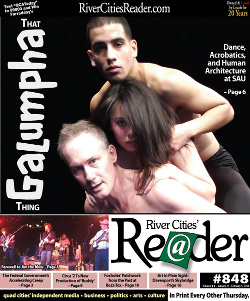 When telling friends about particularly unusual and impressive stage performances, "You have to see it to believe it" is a commonly employed cliché. In the case of a stage performance by the East Coast talents of Galumpha, the latest guests in Quad City Arts' Visiting Artists series, a more appropriate sentiment might be "You have to see it to understand it." (And, also, to believe it.)
When telling friends about particularly unusual and impressive stage performances, "You have to see it to believe it" is a commonly employed cliché. In the case of a stage performance by the East Coast talents of Galumpha, the latest guests in Quad City Arts' Visiting Artists series, a more appropriate sentiment might be "You have to see it to understand it." (And, also, to believe it.)
Delivering an unclassifiable blend of modern choreography, acrobatics, physical comedy, martial arts, and even the art of "human architecture," Galumpha will, following its week of outreach-program appearances, present its public performance at St. Ambrose University's Galvin Fine Arts Center on January 25. And if you attend the show that night, you'll no doubt understand why it's so difficult to effectively summarize the Galumpha experience, given that it involves a series of frequently jaw-dropping movement- and balance-based routines as unique as the company's name.
Explaining the origin of that moniker, Galumpha co-founder Andy Horowitz says, "Whenever you get a group of people doing something unusual together, a unique vocabulary starts to emerge. And we have names for all of our lifts, and they're often kind of intuitive, and so we used to say, 'Let's do that galumpha thing' - this kind of clumsy, heavy lift in which one person walks around the stage carrying the other two. And so when we were founding Galumpha Inc. and needed a name, we just used it. We thought it was catchy and funny and unique.
"And especially in the era of the Internet," Horowitz continues, "it's great to have a name that's unlike anything else. If you Google 'Galumpha,' the first several hundred pages are just gonna be us."
My own Google search of "Galumpha" ended after 31 pages, but Horowitz's point is well made; his company is featured on every single link, several of which boast video of the group's incredible routines. And if you click on even a few of those links, you'll likely find a quote from one of the artists' rave reviews, be it the Washington Post labeling Galumpha "a giddy balancing act," or the San Francisco Chronicle cheering, "Their strength, agility, and underlying grace ... is unflagging and amazing," or the Boston Globe calling the experience "preposterous, wonderful stuff."
Citing another influence for his company's name, and a further explanation of Galumpha's style, Horowitz says, "In his book Free Play: The Art of Improvisation, Steve Nachmanovitch has a whole chapter on what he calls 'galumphing,' which he defines as 'giving more energy to a task than is necessary to complete that task.' And that definition just filled me with joy, because that's exactly what we do."
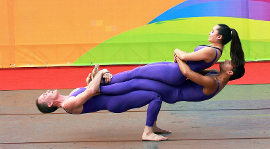 Male, Testosterone-Driven, and Goofy
Male, Testosterone-Driven, and Goofy
Although the company currently performs more than 150 live shows per year and maintains a consistent international touring schedule, Galumpha's road to success, as Horowitz says, was as unpredictable as Galumpha itself.
It began in the mid-1980s, when Horowitz declared a theatre major at New York's Binghamton University, and made the acquaintance of fellow majors Paul Gordon and Greg O'Brien, the latter of whom was pursuing his degree with a specific focus on dance.
"We were just three guys, three university students," says Horowitz, "and we started to work together because we found we had a shared sense of humor. But we also found that the three of us had very good strength-to-weight ratios. We were light and strong, and each one could easily lift the other two. And when we discovered that, we began to explore this phenomenon choreographically."
Although not a dancer in his youth, Horowitz says, "I was an acrobat and a martial artist. So I didn't have any dance technique, per se, but I wasn't as disadvantaged as guys who aren't limber at all when they first start trying to dance in early adulthood. So I picked it up pretty quickly, and was able to use my acrobatic and martial-arts skills to get over the technique hurdle."
Practicing what Horowitz calls "this kind of male, testosterone-driven, goofy kind of approach to modern dance, kind of like what Moses Pendleton was doing at Dartmouth with early Pilobolus," the three students felt they were on to something fresh and unusual, and spent the next several years honing their skills throughout New York: "We'd sort of get $50 to do a gig one place, and maybe $40 to perform at a park somewhere ... ."
Seeking greater awareness (and profitability) for their troupe, which was then called the Second Hand Dance Company, Horowitz says that in 1987, "I applied for a grant called the Thayer Fellowship. It's a grant that's given to one New York State artist - one undergraduate-student artist - per year. And it's extremely competitive, because it tries to judge all artists against each other regardless of the discipline. So we were competing against videographers, poets, other dancers, filmmakers, actors, studio painters, trombonists ... . Anything you could think of. And we were selected as the finalists representing the general category of 'dance,' and invited to the finals at SUNY Purchase [College]."
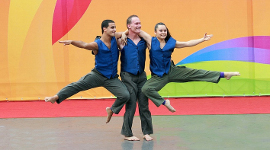 Yet there was a hitch. "The panel of judges watched our audition and loved it," says Horowitz, "but they were completely mystified. They said, 'Okay, we realize you guys have been chosen to represent dance, but we're not even sure this crazy kind of acrobatic-dance stuff is dance. So we're gonna invite another person to join the panel of judges.' And that turned out to be Marc Russell, who was artistic director of a well-known downtown New York City performance space called P.S. 122."
Yet there was a hitch. "The panel of judges watched our audition and loved it," says Horowitz, "but they were completely mystified. They said, 'Okay, we realize you guys have been chosen to represent dance, but we're not even sure this crazy kind of acrobatic-dance stuff is dance. So we're gonna invite another person to join the panel of judges.' And that turned out to be Marc Russell, who was artistic director of a well-known downtown New York City performance space called P.S. 122."
Russell watched Second Hand's set, and while Horowitz's company didn't end up receiving the grant, it did land an important new fan. "Later, after the audition, Marc said, 'I don't know what to call you, but I'm gonna book you to perform at my theatre.' And that's what really launched our careers. It was an amazing turn of events." Although maybe not quite as amazing as what happened next.
"About a month after we met Marc," says Horowitz, "he gives me a call and says, 'Andy, I'm having cold feet about bringing your company in to perform at P.S. 122 all on its own. I like you, but you're completely unknown in New York City, and I don't want to risk disappointing my audience. So what I'd like to do is bring in this other act and have them do Act I, and then have you guys swoop in for Act II. And that way if you guys suck, maybe the audience will at least like the first group, and I'll have a bit more protection against a disaster.' So I said, 'Fine. That's great.'
"Of course, we were just three students from Binghamton University," he continues. "We didn't know, for example, that you're supposed to ring agents' phones off the hook and try to get 'em to come see your show, or that you're supposed to call every dance critic you can think of, hoping against hope that they're gonna review your show. We didn't know this, but the other group did.
"So this other group - they were called Watchface - did their act, and then we did our act, and we brought the house down. I mean, the audience stood up, and they were screaming and clapping ... . And the very next morning a rave review came out in the New York Times. It was by Burt Supree, the late and very famous dance critic, and one of the superlatives he wrote, which we quoted for years after, was 'superb, even amazing physical control.'
"It was incredible," says Horowitz, "because we didn't do any legwork for it. The other group did. And I'm embarrassed to say that Watchface wasn't even mentioned in the review. To the benefit of this other, weird company of kids from Binghamton."
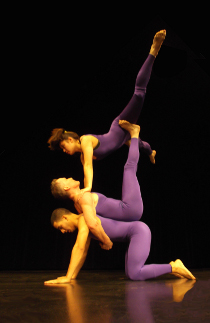 Shared Weight Experience
Shared Weight Experience
Beyond Supree, other, even more significant patrons turned out to be in the audience for Second Hand's debut at P.S. 122.
"I was in my dressing room after the show," says Horowitz, "and I get a knock on the door, and it's a guy named Tom Parker, who at the time was vice president for a very large theatrical booking agency called Shaw Concerts. And he said, 'We loved you, and we want to sign you for a three-year contract.' And we pretty much signed with Shaw on the spot, and started to work coast-to-coast in the USA."
After three years spent performing and growing as an organization - adding more and more detailed lighting, costumes, and music and sound effects - "our first international gig was in Montreal, Canada, in 1990, followed very quickly by a tour of Europe in 1991," Horowitz says. "And since then, we've upheld a vigorous international tour schedule, and continue to perform all over the world."
Second Hand's touring schedule wasn't even impeded by Paul Gordon's eventual decision to leave the group, and the 2002 name change to Galumpha.
"The Second Hand Dance Company was a three-way legal partnership in New York," says Horowitz, "and when one of the partners wanted to leave, rather than argue over the legacy of the name, we simply founded a new company. But by the time we founded it, he [Gordon] had already replaced himself in the company, and the entire roster of artists and technical staff all just turned into Galumpha, performing the exact same repertoire. So there's no real difference between Galumpha and the Second Hand, other than the name."
That, and the likely increase in the group's international popularity. "Just two months ago," Horowitz says, "we had a 10-show run in Shangai, which was great. I actually lived in China for a year, but this was the first time that my dance company had ever performed in China, although we have performed in many east-Asian countries before, including South Korea, Japan, and Singapore."
His company's success in Asia, as Horowitz suggests, may have much to do with his martial-arts training, and the training of the group's Emiko Okamoto, who began performing with Galumpha in late 2011.
"It's not that I'm directly inspired by the East," says Horowitz, "but I've always done martial arts, and I think that it just seeps into my choreography. It's so much a part of my body that even when I think I'm just dancing, the martial-art component comes out. And Emiko is also a martial artist, and so especially in a lot of the newer work that we've choreographed in the last few months - some of which we'll be doing in Davenport on January 25 - you'll see even more of that Eastern influence."
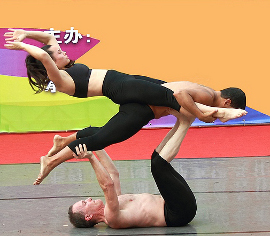 You'll also see, according to Horowitz, a number of the classic Galumpha routines that have thrilled live audiences and TV viewers alike.
You'll also see, according to Horowitz, a number of the classic Galumpha routines that have thrilled live audiences and TV viewers alike.
"We're going to do numbers that go all the way back to the beginning in the '80s," he says, "and that have, for some reason, outlived the others. I mean, we do a dance where we attach frying pans to our butts, and we kick them with little spurs that are on our heels. I guess it's sort of a bizarre form of tap dancing, or step dancing.
"We first performed this is 1987, and my buddy Greg was almost too embarrassed to go through with it. It just seemed like the stupidest thing, but we did it out of this spirit of trying anything, and it instantly became one of our most popular pieces. It's so simple, yet we have such a great time making rhythms and playing off each other that to this day, we typically end a show with it. People are just dumbfounded by it.
"And another one that's not quite as old as that one, but that we've done for a while, is where we wear Velcro hats on our heads and throw and catch Velcro balls. That's another one where we just went, 'Aw, hell, this is so nuts, but let's give it a try ... .' And when we were contacted by David Letterman's show and asked to perform, that was the piece they wanted. And that's what we did."
But while you can expect both time-tested and recently invented routines when Horowitz, Okamoto, and performance partner William Matos present Galumpha's public concert, one thing you shouldn't expect is a lot of accidental tumbles. Although they do happen.
"One thing we've learned over the years is how to fall out of a shared weight experience," says Horowitz. "We've become very adept at knowing where the others are, and we fall in ways that protect ourselves and each other at the same time. I'm not even sure how to teach it, but all I can say is if you lift each other tens of thousands of times and fall maybe 2 percent of the time, you're going to get good at this." Laughing, he adds, "Probably over a lot of bruises."
However, Horowitz says, "as a corporation, we have to invest in workers' comp, and as the president and director of Galumpha Inc., I have never once fielded any kind of workers'-comp claim, despite our doing more than 150 shows a year. You hire the right people who have an instinct about safety, and you work slowly and carefully ... . I mean, if something feels dangerous in rehearsal, we'll stop there, and we won't do it anymore."
As Horowitz suggests, however, Galumpha will inevitably try something else just as unique.
"I say to the others, 'If it were easy, we wouldn't fall, but it wouldn't be entertaining, either.' I mean, it's our job to take risks, and we do. And you know, if an idea seems really scary - if an idea seems almost impossible because you can't imagine having the chutzpah to do it - it's probably a good one."
Galumpha performs at St. Ambrose University's Galvin Fine Arts Center (2101 Gaines Street, Davenport) on Saturday, January 25 at 7:30 p.m., and more information and tickets are available by calling (563)333-6251 or visiting QuadCityArts.com or SAU.edu/galvin.
For more information on Galumpha, visit Galumpha.com.










